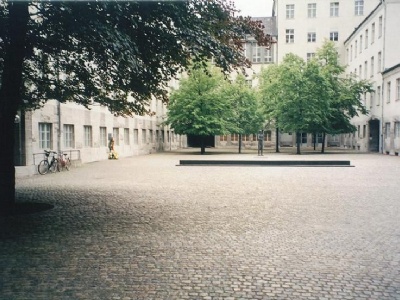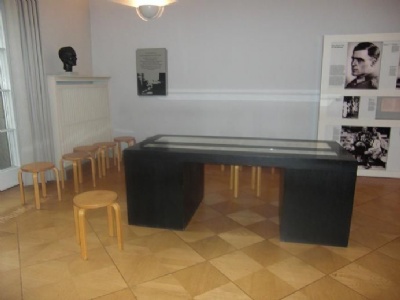Bendlerblock
The German war ministry was located at Bendlerblock in Berlin and it was there that resistance against Hitler took shape. A resistance that has emerged within the older and aristocratic officer corps and which, in line with the military adversities, wanted to bring about a change in the war. The German officer corps with Prussian ancestry had always considered themselves above (or at least outside) politics and not let themselves be controlled by politicians. But Hitler had nevertheless succeeded in reconciling both his and the military’s ambitions, a relationship that worked well as long as Germany reaped military success. This was changed in connection with the German defeat outside Moscow in December 1941. Subsequently, the cooperation between Hitler and the officer corps was strained.
The conspiracy thoughts that have existed since the late thirties of some high officers were brought back to life. But the removal of Hitler was easier said than done and fraught with a direct danger to life. Inducing Hitler to step aside voluntarily was not an option, the only way was to murder him, but there were few if any who could and dared to carry out an assassination attempt. Leading officers opposed to Hitler were among others, Ludwig Beck, Hans Oster, Erwin von Witzleben, Carl Friedrich Gördeler and Henning von Tresckow. Very cautiously, they tried to recruit members but the combination of loyalty to the oath of allegiance (to Hitler), a sense of duty and many times a direct fear of acting meant that many did not allow themselves to join the conspiracy.
By 1943, the conspirators had succeeded in recruiting a colonel named Claus von Stauffenberg. Stauffenberg had been injured in North Africa and had subsequently been assigned a post in the reserve army, giving him access to the military conferences at which Hitler was present. Stauffenberg offered to carry out an attack by placing an explosive device at one of the conferences. Secret meetings preceded the assassination attempt and the attempted coup, it was important to find the right time and opportunity. The attempt therefore came at short notice to be postponed a couple of times because the conspirators wanted high Nazi Leaders as Goering and Himmler to be present so they also could be killed
But on July 20, 1944, the conspirators decided to put their plan into action. Early in the morning Stauffenberg flew from Berlin to FHQ Wolfschanze, East Prussia, to attend a military conference. With him, he had a briefcase containing two explosive devices that he planned to place under the conference table about two meters from Hitler. But Stauffenberg and his adjutant Werner von Haeften ended up in time distress and they therefore only managed to capture one of the two explosive devices he had with him.
By the time Stauffenberg arrived at the conference, it had already begun, he put his briefcase under the table. A short while later he left the conference under the pretext of a waiting phone call. Outside the barrack, von Haeften waited in a car and they started driving towards the airport. When the bomb exploded, the alarm went off and all exit routes were blocked off, but Stauffenberg managed to get out of Wolfsschanze and flew back to Berlin to connect with the other coup-makers at Bendlerblock, convinced that Hitler was dead.
But Operation Valkyria (the code name for the coup) had not started immediately after the attack due to uncertainty whether Hitler was dead or not. This uncertainty and indecision meant that valuable time was lost. The idea was to immediately disarm the SS, mobilize the reserve army, take the government quarters and arrest prominent Nazis, including Josef Goebbels. Eventually, Valkyria started, but soon rumors were spread at Bendlerblock that Hitler survived the attack. This in turn led to uncertainty and anxiety among the conspirators. Double messages also reached commanders who did not take part in the coup and during the afternoon and evening there was great uncertainty in Berlin.
But Hitler had miraculously survived the assassination attempt and sustained only minor injuries. The briefcase with the explosive charge had by chance been moved from one side of the table leg to the other, which had the effect of dampening the explosion in Hitler’s direction. The fact that only one explosive device exploded further dampened the explosion. When it was finally confirmed that Hitler survived the attack, the fate of the conspirators was sealed. Stauffenberg, Lieutenant Werner von Haeften, General Friedrich Olbricht and Colonel Albrecht Mertz von Quirnheim were arrested that very evening and executed at Bendlerblock. A fifth conspirator (Ludwig Beck) chose to commit suicide. After the failed attempt, a wave of terror ensued in which thousands of conspirators, suspected conspirators and sympathisers were executed.
Current status: Preserved with museum (2011).
Address: Stauffenbergstrasse 13 – 14, 10785 Berlin.
Get there: Metro to either Kurfürstenstrasse or Potsdamer Platz Station.
Follow up in books: Graml, Hermann (and Others): The German Resistance to Hitler (1970).



A pretty sterile museum where most of it looks like classrooms, but that is perhaps the main purpose of the museum.
The Goal of the conspirators was to, after successfully killing Hitler, initiate peace negotiations with the western allies (US and Britain) and end the war. The opening of peace negotiations with the Soviet Union was not on the agenda of the conspirators. But it’s unlikely that the Western allies had entered into any negotiations whatsoever without the Russians. The German officer corps had too high thoughts of themselves and their direct involvement in both war preparations and war crimes had most certainly thwarted negotiations. The unconditional surrender agreed upon by both the Western allies and the Soviet Union had continued to apply, with or without Hitler.
Even if Hitler had been killed it is very doubtful whether the conspirators would have managed to take over power. Just because it was the army that was the initiator and executor of the attempt, it is directly incorrect to say that the entire army was behind the attempt. It was actually a rather small circle supporting the conspirators and the time after Hitler’s death had probably become extremely chaotic with several potential challengers to the power vacuum that had arisen. A vacuum where the conspirators absolutely should not be seen as the obvious victor.
One who was happy that Hitler survived the attack was strangely enough Stalin. The reason for this was because Stalin’s suspicion of his western allies, particularly Churchill, that they, together with a Germany without Hitler, would join forces and continue the war against the Soviet Union. Therefore, Stalin rejected all plans to try to assassinate Hitler during the war. Sure, Stalin was paranoid and saw enemies everywhere, but in Churchill’s case there was reason for his suspicion. Churchill’s anti-communism was no secret and he was open to President Roosevelt and his associates with his aversion to Stalin. For Churchill, Stalin was a man to take as seriously as Hitler. Stalin was a threat to British interests in East and Southern Europe if given free hands.